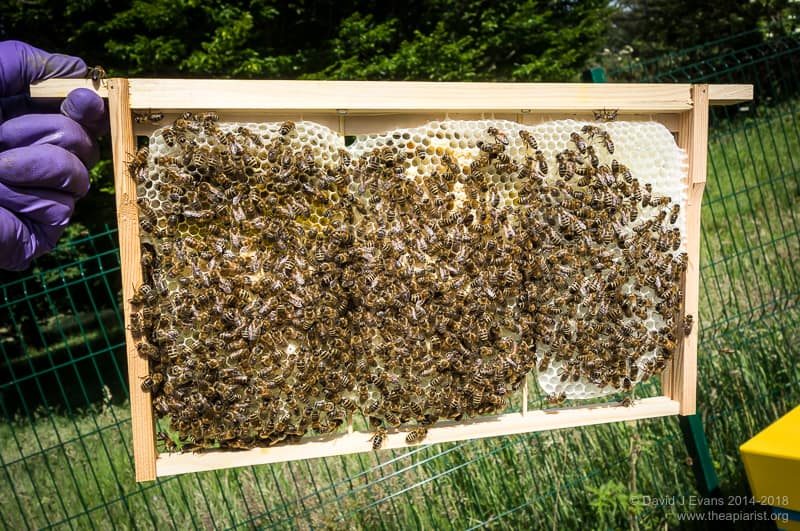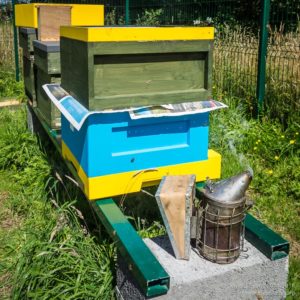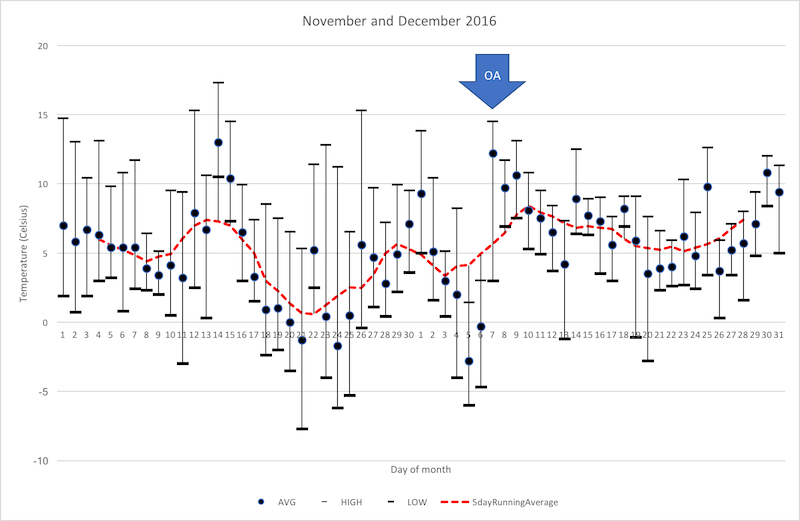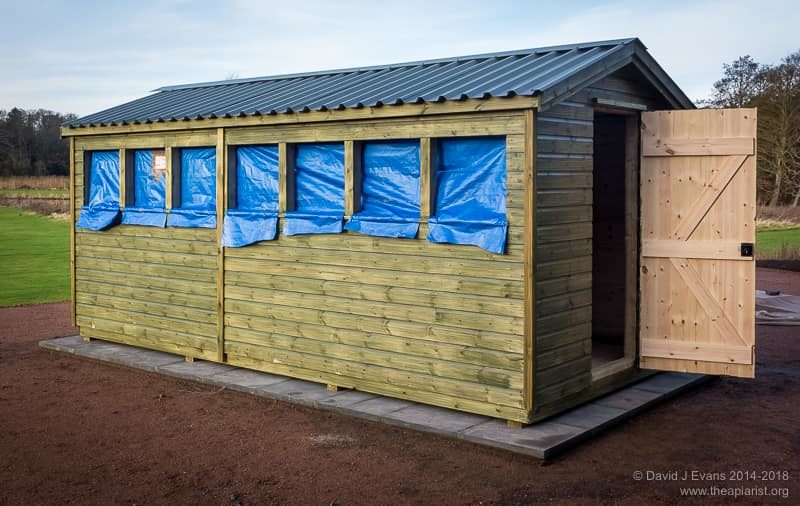2017 in retrospect
The end of the year is a good time to look back at the highs and lows of the season. What worked … what didn’t work … what on earth happened to our weather in June?
June is an important month here in Fife. Early season colony buildup should be pretty much complete, most colonies will have had some sort of swarm control measures in late May, virgin queens may well be present in many hives, the OSR is over and colonies need to consolidate for the main summer flows.
But instead it just rained.
Rainfall in Fife was 225% the 40 year average, access to apiaries was problematic due to flooding and queens could only get out to mate if they were wearing ‘water wings‘.
Big mistake
Many colonies needed to be, or should have been fed, during June. Mine had reasonable levels of stores as I’d not taken much early season honey. I therefore chose not to feed them. In retrospect I think this was a big mistake.
Although not monitored carefully, I suspect brood rearing slowed, so reducing the colony size to effectively exploit the July/August flows. It was my worst summer honey crop in years.
Lesson one … If this happens next season I’ll continuously feed thin syrup to keep the queen laying strongly.
Doing the splits
Notwithstanding the incessant rain, swarm control – and the inevitable associated queen mating – went pretty well. I generally use splits of one form or another and most queens got out to mate, albeit a little slower than I’d have liked. If swarm control is needed for colonies in the bee shed we can’t do vertical splits (because of the way entrances are organised) and instead just take a nucleus colony away and let them rear a new queen.
Only ‘pretty well’ though because I suspect I lost a cast from a vertical split that went calamitously wrong. I’d left the queenless half far too strong and inadvertently also left multiple developing queen cells.
D’oh!
This wasn’t going to end well 🙁
I did manage to capture and hive another cast from the same colony, but the first virgin queen and well over half the workers were long gone.
So, lesson two (which I’ve been taught many times before 😥 ) is to be decisive when there are multiple queen cells in a split. Either knock them back appropriately (which I’ll explain next year) or split the box up into multiple nucs. Don’t dither. Don’t prevaricate and don’t – as I think I did this year – simply forget to check.
All the gear, some idea
I blatantly poached how to build foundationless frames with bamboo skewers from the internet. I claim zero originality here. It isn’t my idea. However, I’m pleased to say it was a great success. Simple wooden starter strips were also a roaring success. It’s very satisfying when you realise you don’t need to spend £1 per frame on foundation.
I’ve used quite a few Abelo poly hives this season. They’re a strident colour – blue and yellow – but reasonably well made. Colonies checked this winter are doing well in them, with bees right up to the side walls on sub-zero days. This suggests to me that they are well insulated.
There are some aspects of these hives I have yet to be fully convinced by; upper entrances, the crownboard, high condensation levels and a small Varroa tray. I’ll review them more fully when I’ve been using them for at least a full year.
Old invasives …
The bête noire of most beekeepers, the Varroa mite, has featured heavily throughout the year. In print, though thankfully not in my colonies. I’ve tried to emphasise the need to treat appropriately, using the right miticide at the right time. Since most approved (and even some unapproved 😉 ) miticides are all pretty effective, the timing of treatment is probably the most important point.
In three recent posts I presented the importance of midwinter treatment, how to prepare the oxalic acid-containing miticide and how to administer it. These should probably be read in conjunction with an earlier article on when to treat, which I’ll come back to in a minute. Finally, as far as Varroa is concerned, I discussed potential ways to optimise the timing of the winter treatment by watching the weather. I suspect that most beekeepers treat too late in the winter.
If you have yet to treat this winter … get a move on!
… and new ones
The new invasive that got some coverage was, inevitably, the Asian hornet. Having first arrived in 2016 I think we’ll be subjected to annual incursions until it gets established here. Constant vigilance is going to be needed to help postpone what might be inevitable. Just because it is inevitable doesn’t mean we shouldn’t try and delay it’s permanent arrival.
Devon beekeepers got some first-hand experience of how vigilant you need to be to both spot and photograph Asian hornets in September. Martin Hocking has written about his experience in the Devon Beekeeper (pp172 and also in November’s Bee Craft) which should be required reading for beekeepers, with a follow up article about his experience in December (see pp196; apologies but they’ve taken all these articles offline). There’s an open meeting on the 20th of January at Harberton Parish Hall, TQ9 7SD where the threat posed by the Asian hornet – and how to mitigate it – will be discussed.
Although rarely mentioned this year, Small Hive Beetle now appears to be established in the Calabria region of Southern Italy. Data updated in late September and November indicates that positive wild colonies and sentinel nucleus colonies are still being found, indicating that attempts to eradicate the beetle have failed. Infested colony numbers are perhaps a bit lower than previous years, but since there’s no readily-available data on the level of surveillance, it’s not clear whether this shows that control is having an effect, or if people are just not looking as hard.
www.theapiarist.org
Posts have been made every Friday of the year, with a few additional ones when something important happened (Asian hornets or I was ‘advertising’ a Convention I was speaking at … OK, my talk wasn’t important, but the Welsh Beekeepers Convention was 😉 ).

Regular as clockwork …
The Friday posts are intentional. It’s when most of us have time to read stuff. The regularity was not and, frankly, it’s a bit of a surprise I’ve achieved it. However, there it is. No promises it’ll continue like that. You can register to receive email notification of new posts in the right hand panel.
Visitor numbers to the site are markedly increased from last year. Page views per visit are down fractionally, but not significantly. It’s clear that more are finding the site as it becomes better indexed by the search engines, and as pages are referenced by other sites.

24 months on www.theapiarist.org …
My attempts at generating a presence on Facebook was an abject failure. I simply don’t have time to do anything other than automagically post updates from here on Facebook (as I do on Twitter, which I’m a bit more familiar and competent with … follow me on @The_Apiarist). Apologies if you tried to ‘Friend’ me (or whatever) on Facebook. I’ve cancelled all the email updates as I simply couldn’t keep up. Or, when I tried, I didn’t know how to! I belong to the pre-FB generation, or the one before that.
Beekeeping is international, with different problems – but many shared ones – globally. I’m grateful to the visitors from 161 different countries and the European Union 🙂 Less than 50% of the readers are from the UK, despite the UK-centric bias I inevitably exhibit (°C, colour, no mention of queen castles or slatted racks, precious little discussion of Langstroth hives etc.). Southern hemisphere beekeepers don’t even do things at the same time of the year, so many of the posts aren’t even topical for readers in Australia, New Zealand and South America. Whatever, I’m grateful people took the time to visit and read stuff.
And the winner is …
I don’t publish visitor numbers, but I do comment on the popularity of particular pages. For several years a post on my honey warming cabinet has been the most popular. It was originally posted ‘way back’ in 2014. Frankly, it was useful, but not particularly challenging or exciting.
But it’s all change this year. Aside from the homepage, the archive and blog pages, all of which people arrive at to to get the most recent posts, the honey warming cabinet post was a distant fourth in the 2017 rankings.
Above it were posts on vertical splits and making increase, feeding fondant and – particularly pleasingly and top this year – when to treat colonies with miticides against Varroa. I say particularly pleasingly as the When to treat? post is a serious article on an important subject, underpinned by scientific arguments. The timing of the late summer treatment is probably one of the most important events in influencing the health and overwintering success of the colony. This post was almost twice as popular as any other post this year which – because it originally appeared in early 2016 – suggests it is finally being widely cited and accessed by beekeepers.

When to treat? Finally getting read when it should be.
And what does the future offer?
Frankly, as I write this in mid-December with a streaming cold, a box of tissues and slathered in Vicks VapoRub (really, it’s not a pretty sight) I don’t know. I have two priorities at the moment; getting the new bee shed properly setup and (with my researcher hat and lab coat on) starting studies of Chronic Bee Paralysis Virus. Both will get coverage here.
In terms of the website I’m acutely aware there’s no proper indexing or rational list of articles on particular subjects, perhaps other than Varroa. I hope to bring some order to the chaos, allowing me to not repeat myself, to develop some themes more fully and to not repeat myself 😉 . I also know I have a load of unwritten stuff on queen rearing.
Winter time is also DIY time … dabbling with wood, perspex, Correx and Elastoplasts. Something will surely result from this, in addition to the blood loss and bad language.
If there are things you’d particularly like to read drop me a note. I’m interested in the science underlying beekeeping and have little patience with some of the dogma and That’s the way we’ve always done it stories. I’ve already written about the importance of training and the responsibilities of beekeepers. I’ve got some more on these areas planned as I think they’re too often ignored by beekeepers in the UK.
With Best Wishes for 2018. May your colonies be docile, your supers unliftable, your queens well-mated and your swarms (again) in my bait hives 😉
Happy New Year





Join the discussion ...